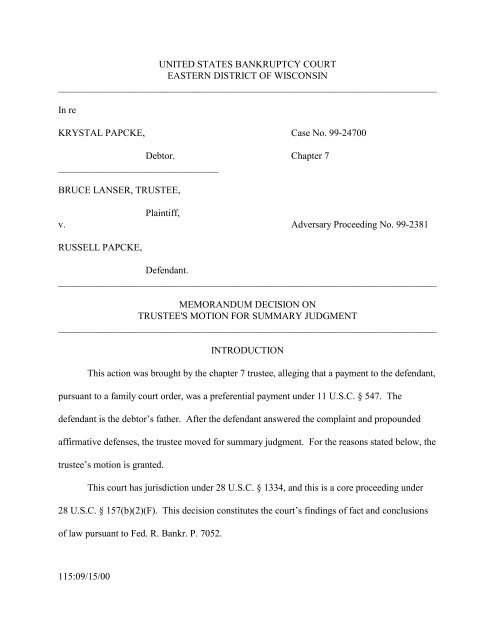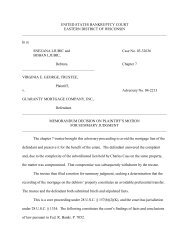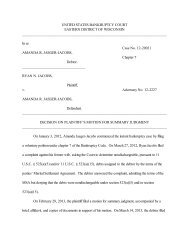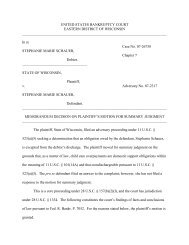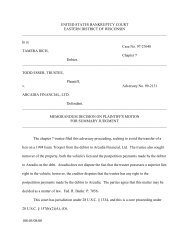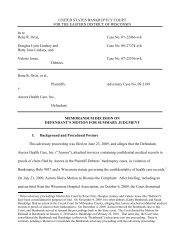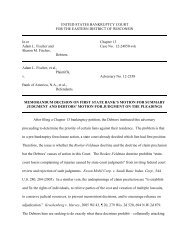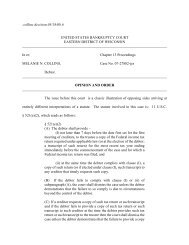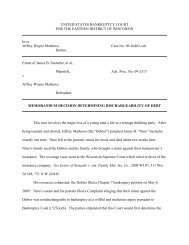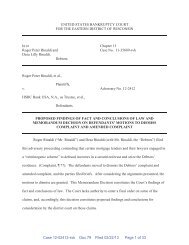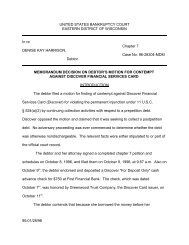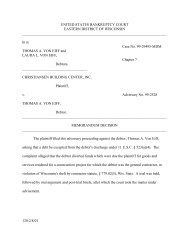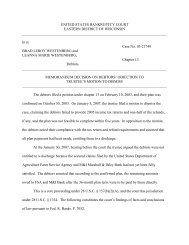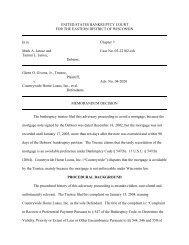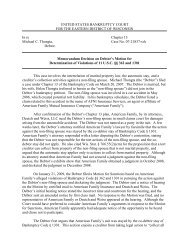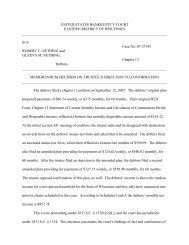In re Krystal Papcke, Case No. 99-24700, Bruce Lanser, Trustee v ...
In re Krystal Papcke, Case No. 99-24700, Bruce Lanser, Trustee v ...
In re Krystal Papcke, Case No. 99-24700, Bruce Lanser, Trustee v ...
Create successful ePaper yourself
Turn your PDF publications into a flip-book with our unique Google optimized e-Paper software.
UNITED STATES BANKRUPTCY COURT<br />
EASTERN DISTRICT OF WISCONSIN<br />
______________________________________________________________________________<br />
<strong>In</strong> <strong>re</strong><br />
KRYSTAL PAPCKE, <strong>Case</strong> <strong>No</strong>. <strong>99</strong>-<strong>24700</strong><br />
Debtor. Chapter 7<br />
_________________________________<br />
BRUCE LANSER, TRUSTEE,<br />
Plaintiff,<br />
v. Adversary Proceeding <strong>No</strong>. <strong>99</strong>-2381<br />
RUSSELL PAPCKE,<br />
Defendant.<br />
______________________________________________________________________________<br />
MEMORANDUM DECISION ON<br />
TRUSTEE'S MOTION FOR SUMMARY JUDGMENT<br />
______________________________________________________________________________<br />
INTRODUCTION<br />
This action was brought by the chapter 7 trustee, alleging that a payment to the defendant,<br />
pursuant to a family court order, was a p<strong>re</strong>fe<strong>re</strong>ntial payment under 11 U.S.C. § 547. The<br />
defendant is the debtor’s father. After the defendant answe<strong>re</strong>d the complaint and propounded<br />
affirmative defenses, the trustee moved for summary judgment. For the <strong>re</strong>asons stated below, the<br />
trustee’s motion is granted.<br />
This court has jurisdiction under 28 U.S.C. § 1334, and this is a co<strong>re</strong> proceeding under<br />
28 U.S.C. § 157(b)(2)(F). This decision constitutes the court’s findings of fact and conclusions<br />
of law pursuant to Fed. R. Bankr. P. 7052.<br />
115:09/15/00
FACTS<br />
The <strong>re</strong>levant facts a<strong>re</strong> as follows. The debtor, <strong>Krystal</strong> <strong>Papcke</strong>, formerly known as <strong>Krystal</strong><br />
Downs, filed for divorce from her husband, Paul Downs, on August 18, 1<strong>99</strong>7. While the divorce<br />
was pending, Mr. Downs became awa<strong>re</strong> that a worker's compensation award was forthcoming to<br />
Ms. <strong>Papcke</strong>. Concerned that the funds might be dissipated if they we<strong>re</strong> paid to Ms. <strong>Papcke</strong><br />
befo<strong>re</strong> the court divided the couple’s property, Mr. Downs demanded that those funds be<br />
included in the martial estate. He filed a motion to modify the temporary order to bring those<br />
funds within the court's jurisdiction. The court orde<strong>re</strong>d Ms. <strong>Papcke</strong>'s attorney to deposit the<br />
worker's compensation proceeds into his trust account until further di<strong>re</strong>ction of the court.<br />
Befo<strong>re</strong> trial, the parties ente<strong>re</strong>d into a partial settlement ag<strong>re</strong>ement <strong>re</strong>solving a number of<br />
issues un<strong>re</strong>lated to the transaction which is the subject of this action. Then, at the time of trial,<br />
the parties ente<strong>re</strong>d into an oral ag<strong>re</strong>ement, which the court incorporated into its Findings of Fact,<br />
Conclusions of Law and Judgment of Divorce, dated January 6, 1<strong>99</strong>9. (Judgment 11j.-l.).<br />
Appa<strong>re</strong>ntly, as a means to balance out the assets and debts of the marital estate, the parties ag<strong>re</strong>ed<br />
that Mr. <strong>Papcke</strong> <strong>re</strong>ceive the enti<strong>re</strong> amount of the funds held by Ms. <strong>Papcke</strong>’s attorney, which<br />
totaled $9,542. The sum was awarded to Mr. <strong>Papcke</strong> to obtain a <strong>re</strong>lease of a lien on a Pontiac<br />
Bonneville awarded to Mr. Downs. Ms. <strong>Papcke</strong> ag<strong>re</strong>ed to hold Mr. Downs harmless on the debt<br />
due her father for the purchase of the car, which the divorce dec<strong>re</strong>e states was in the original<br />
amount of $5,000. The funds we<strong>re</strong> disbursed to Mr. <strong>Papcke</strong> di<strong>re</strong>ctly from the trust account of<br />
Ms. <strong>Papcke</strong>'s attorney on January 7, 1<strong>99</strong>9. Ms. <strong>Papcke</strong> filed a petition for chapter 7 <strong>re</strong>lief on<br />
May10, 1<strong>99</strong>9.<br />
115:09/15/00 2
Mr. Downs’ financial statement dated September 25, 1<strong>99</strong>8, which was filed in his and the<br />
debtor’s divorce proceeding, lists R. <strong>Papcke</strong> as the lienholder on the Bonneville, with a $5,000<br />
lien. He states that the car had a NADA value of $3,125 as of September 1<strong>99</strong>7, and <strong>Krystal</strong><br />
Downs’ financial disclosu<strong>re</strong> statement dated August 19, 1<strong>99</strong>6, estimated the value at $2,500.<br />
The financial statement of Paul Downs also lists Russell <strong>Papcke</strong> as a c<strong>re</strong>ditor for a cycle with an<br />
unknown value, and <strong>Krystal</strong> Downs’ statement shows a “Harley” as having a value of $14,500<br />
1<br />
with a <strong>re</strong>maining debt of $6,222.24. The debtor's bankruptcy schedules do not list any debt<br />
owed to Mr. <strong>Papcke</strong>. Mr. <strong>Papcke</strong>’s affidavit filed in this adversary proceeding asserts that he<br />
loaned the couple approximately $40,000 during the marriage.<br />
ARGUMENTS<br />
The trustee contends that the debtor's attorney, on behalf of the debtor, ag<strong>re</strong>ed on the<br />
<strong>re</strong>cord befo<strong>re</strong> the family court that out of his trust account he would pay Mr. <strong>Papcke</strong> the debtor's<br />
proceeds from a worker's compensation injury. The transfer was of an inte<strong>re</strong>st in property of the<br />
debtor, and made to the debtor's father, an insider, within one year prior to the filing of the<br />
chapter 7 petition, on account of an antecedent debt. The transfer was made when the debtor was<br />
insolvent, and it enabled the defendant to <strong>re</strong>ceive mo<strong>re</strong> money than he would have <strong>re</strong>ceived if the<br />
transfer had not been made and if the defendant had <strong>re</strong>ceived a dividend under a chapter 7<br />
distribution.<br />
Mr. <strong>Papcke</strong> asserts that summary judgment is not appropriate because he disputes<br />
whether the transfer by the debtor was voluntary and whether the defendant knew or had <strong>re</strong>ason<br />
1<br />
The <strong>re</strong>cord does not <strong>re</strong>veal who was awarded the Harley.<br />
115:09/15/00 3
2<br />
to know that the debtor was insolvent at the time of the transfer. He argues that the funds we<strong>re</strong><br />
not property of the debtor as they we<strong>re</strong> never in the control of the debtor. He further asserts that<br />
the worker's compensation proceeds a<strong>re</strong> exempt as to the debtor and would not be distributable to<br />
c<strong>re</strong>ditors because she could <strong>re</strong>cover the proceeds from the trustee pursuant to 11 U.S.C § 522(g). 3<br />
DISCUSSION<br />
The elements of a voidable p<strong>re</strong>fe<strong>re</strong>nce a<strong>re</strong> set forth in § 547(b) of the Code:<br />
Except as provided in subsection (c) of this section, the trustee may avoid any transfer of<br />
an inte<strong>re</strong>st of the debtor in property --<br />
(1) to or for the benefit of a c<strong>re</strong>ditor;<br />
(2) for or on account of an antecedent debt owed by the debtor befo<strong>re</strong> such<br />
transfer was made;<br />
(3) made while the debtor was insolvent;<br />
(4) made --<br />
(A) on or within 90 days befo<strong>re</strong> the date of the filing of the petition; or<br />
(B) between ninety days and one year befo<strong>re</strong> the date of the filing of the<br />
petition, if such c<strong>re</strong>ditor at the time of such transfer was an insider; and<br />
(5) that enables such c<strong>re</strong>ditor to <strong>re</strong>ceive mo<strong>re</strong> than such c<strong>re</strong>ditor would <strong>re</strong>ceive if -<br />
-<br />
2<br />
The 1<strong>99</strong>4 amendments to 11 U.S.C. § 547 did away with the <strong>re</strong>qui<strong>re</strong>ment that the<br />
defendant not know or have <strong>re</strong>ason to know of the debtor’s insolvency, and this defense need not<br />
be add<strong>re</strong>ssed.<br />
3<br />
Section 522(g) provides as follows:<br />
(g) <strong>No</strong>twithstanding sections 550 and 551 of this title, the debtor may exempt under<br />
subsection (b) of this section property that the trustee <strong>re</strong>covers under section 510(c)(2),<br />
542, 543, 550, 551, or 553 of this title, to the extent that the debtor could have exempted<br />
such property under subsection (b) of this section if such property had not been<br />
transfer<strong>re</strong>d, if --<br />
(1) (A) such transfer was not a voluntary transfer of such property by the debtor;<br />
and<br />
(B) the debtor did not conceal such property; or<br />
(2) the debtor could have avoided such transfer under subsection (f)(2) of this<br />
section.<br />
11 U.S.C. § 522(g).<br />
115:09/15/00 4
(A) the case we<strong>re</strong> a case under chapter 7 of this title;<br />
(B) the transfer had not been made; and<br />
(C) such c<strong>re</strong>ditor <strong>re</strong>ceived payment of such debt to the extent provided by<br />
the provisions of this title.<br />
11 U.S.C. § 547(b). Various defenses a<strong>re</strong> found in 11 U.S.C. § 547(c). The trustee has the<br />
burden of proving the avoidability of a transfer under subsection (b), and the c<strong>re</strong>ditor has the<br />
burden of proving any defenses. 11 U.S.C. § 547(g).<br />
The only element of 11 U.S.C. § 547(b) that is disputed by Mr. <strong>Papcke</strong> in his answer, his<br />
memorandum in opposition to the trustee’s motion for summary judgment, or in his affidavits or<br />
exhibits is whether the funds transfer<strong>re</strong>d constituted “an inte<strong>re</strong>st of the debtor in property.” He<br />
<strong>re</strong>asons that because the worker’s compensation award was not available to his daughter, she did<br />
not have an inte<strong>re</strong>st in the property transfer<strong>re</strong>d. This argument is unavailing. The fact that the<br />
funds we<strong>re</strong> deposited in her attorney’s trust account, and she had no control over them, did not<br />
mean they we<strong>re</strong> not her property. <strong>No</strong> one else had a beneficial inte<strong>re</strong>st in these proceeds. They<br />
we<strong>re</strong> awarded to her because of her injury. They we<strong>re</strong> subjected to property division in her<br />
divorce as they we<strong>re</strong> part of her marital estate. They we<strong>re</strong> used to pay a debt for which she was<br />
liable. The fact that she was not allowed to spend this money pending the outcome of her<br />
divorce did not make the funds any less hers. Thus, an inte<strong>re</strong>st in her property was transfer<strong>re</strong>d<br />
when Mr. <strong>Papcke</strong> was paid.<br />
All submissions by both parties support all the other elements of 11 U.S.C. § 547(b), so<br />
the next inquiry is whether any of the defenses of 11 U.S.C. § 547(c) apply. Mr. <strong>Papcke</strong>’s<br />
<strong>re</strong>maining defenses <strong>re</strong>st on his assertions that the payment to him was involuntary, and worker’s<br />
compensation proceeds a<strong>re</strong> exempt. If funds a<strong>re</strong> exempt, they a<strong>re</strong> not available for distribution<br />
115:09/15/00 5
y the trustee. Furthermo<strong>re</strong>, the debt owed to Mr. <strong>Papcke</strong> was not solely the debt of the debtor,<br />
but rather a joint debt of the marital estate. Mr. <strong>Papcke</strong> asserts that he gave contemporaneous<br />
consideration for funds <strong>re</strong>leased to him because they <strong>re</strong>sulted in the <strong>re</strong>lease of the lien of a<br />
vehicle awarded to the debtor's former spouse, as well as other collateral that is not identified.<br />
The <strong>re</strong>lease also <strong>re</strong>sulted in the debtor ag<strong>re</strong>eing to hold her former husband harmless as to debts<br />
owed to her father. This benefit to the debtor's former spouse constituted contemporaneous<br />
consideration for the debtor. This court finds all of these defenses inadequate as a matter of law.<br />
Section 547(c)(1) states that a transfer that is intended to be and actually is a<br />
contemporaneous exchange for new value <strong>re</strong>ceived by the debtor cannot be <strong>re</strong>cove<strong>re</strong>d by the<br />
trustee. The new value in this case was <strong>re</strong>lease of the lien on a car awarded the debtor’s spouse,<br />
worth considerably less than the amount of the transfer, plus the <strong>re</strong>lease of other unspecified<br />
property. As the defendant cannot identify other liens, the court is satisfied that payment in<br />
excess of the value of the car was payment of an unsecu<strong>re</strong>d debt.<br />
Generally, the <strong>re</strong>lease of the lien on the car would constitute consideration to the debtor<br />
up to the value of the car. The value of the consideration could be no mo<strong>re</strong> than the c<strong>re</strong>ditor<br />
could have <strong>re</strong>cove<strong>re</strong>d for its security, i.e., the value of the collateral. Furthermo<strong>re</strong>, had the<br />
exchange not taken place and the bankruptcy filed, the c<strong>re</strong>ditor in a chapter 7 case would have<br />
<strong>re</strong>ceived at least the value of its security. See 11 U.S.C. § 547(b)(5)(A).<br />
The problem with the defendant’s argument in this case is that the consideration given by<br />
the defendant at the time of the transfer, i.e., <strong>re</strong>lease of a lien on a car valued at $2,500 to $3,125,<br />
passed to the debtor’s former husband, not to the debtor, as is <strong>re</strong>qui<strong>re</strong>d to support a defense under<br />
11 U.S.C. § 547(c)(1). Similarly, in Grassmueck v. Food <strong>In</strong>dus. C<strong>re</strong>dit Union, 127 B.R. 869<br />
115:09/15/00 6
(Bankr. D. Or. 1<strong>99</strong>1), the debtor, pursuant to a dissolution dec<strong>re</strong>e and within 90 days prior to his<br />
bankruptcy petition, made over $4,000 in automobile loan payments for a car that had been<br />
awarded to his former wife. Because these payments satisfied the loan, the c<strong>re</strong>ditor <strong>re</strong>leased its<br />
lien. During the bankruptcy case, the trustee brought an action to avoid the payments as<br />
p<strong>re</strong>fe<strong>re</strong>ntial and to <strong>re</strong>cover them from the c<strong>re</strong>ditor. The court ruled in favor of the trustee,<br />
holding that while <strong>re</strong>lease of a lien ordinarily constituted new value that would protect payments<br />
to a secu<strong>re</strong>d c<strong>re</strong>ditor from avoidance, the fact that the debtor did not own the vehicle subject to<br />
the lien meant that the estate did not benefit from the <strong>re</strong>lease. The<strong>re</strong>fo<strong>re</strong>, the new value exception<br />
did not apply. Id. at 874.<br />
The Grassmueck case was decided prior to the effective date of § 547(c)(7), and the <strong>re</strong>sult<br />
would have been diffe<strong>re</strong>nt if the obligation to pay the loan payments was determined to be in the<br />
natu<strong>re</strong> of support. See, e.g., <strong>In</strong> <strong>re</strong> Whaley, 190 B.R. 818, 822 (Bankr. N.D. Miss. 1<strong>99</strong>5)<br />
(payment of nondischargeable support debt not <strong>re</strong>coverable as p<strong>re</strong>fe<strong>re</strong>nce). However, even the<br />
defendant acknowledges that the transfer was pursuant to a division of property and was not<br />
intended as support for the debtor’s former husband.<br />
The <strong>re</strong>qui<strong>re</strong>ment that the lien <strong>re</strong>lease must be on the debtor’s property for the payment to<br />
constitute a contemporaneous exchange is also consistent with the court’s holding in <strong>In</strong> <strong>re</strong><br />
Pacileo, 87 B.R. 380 (Bankr. W.D. Pa. 1988). <strong>In</strong> that case the debtor husband, pursuant to a<br />
marital ag<strong>re</strong>ement, made various payments to secu<strong>re</strong>d, unsecu<strong>re</strong>d and undersecu<strong>re</strong>d c<strong>re</strong>ditors<br />
within 90 days of commencing his bankruptcy case. After he filed the petition, the trustee<br />
brought suit to <strong>re</strong>cover the allegedly p<strong>re</strong>fe<strong>re</strong>ntial payments. The payments for unsecu<strong>re</strong>d<br />
indebtedness we<strong>re</strong> deemed p<strong>re</strong>fe<strong>re</strong>nces and judgment was ente<strong>re</strong>d in favor of the trustee.<br />
115:09/15/00 7
However, because the debtor's payments to the secu<strong>re</strong>d c<strong>re</strong>ditor we<strong>re</strong> on a mortgage for which<br />
both the debtor and his former wife we<strong>re</strong> obligated, the payments benefitted both the debtor's<br />
property and that of his former wife. Thus, only one-half of the payment to the secu<strong>re</strong>d c<strong>re</strong>ditor<br />
was avoidable as a p<strong>re</strong>fe<strong>re</strong>nce. Id. at 384.<br />
Whether the payment to the defendant could have been or may now be claimed exempt is<br />
not one of the defenses in 11 U.S.C. § 547(c). A transfer that could be claimed exempt by the<br />
debtor befo<strong>re</strong> filing does not mean that the funds a<strong>re</strong> exempt in the hands of the c<strong>re</strong>ditor or<br />
former c<strong>re</strong>ditor. On the contrary, the fact that the debtor may be allowed an exemption in funds<br />
<strong>re</strong>cove<strong>re</strong>d by the trustee indicates an intention by Cong<strong>re</strong>ss that even a transfer of exempt funds<br />
be brought back into the estate. See 11 U.S.C. § 522(g). Only the debtor can claim exemptions,<br />
and any exemption the debtor might have had in the funds cannot be claimed by her transfe<strong>re</strong>e.<br />
th<br />
See 11 U.S.C. § 522(b); <strong>In</strong> <strong>re</strong> <strong>No</strong>blit, 72 F.3d 757 (9 Cir. 1<strong>99</strong>5) (transfe<strong>re</strong>es lacked standing to<br />
raise debtor's homestead exemption as defense to p<strong>re</strong>fe<strong>re</strong>nce action).<br />
Likewise, whether the transfer by the debtor to the defendant was voluntary is of no<br />
consequence in determining the trustee’s right to avoid the transfer. Section 522(g) provides that<br />
the debtor can, under certain circumstances, claim as exempt property <strong>re</strong>cove<strong>re</strong>d by the trustee if<br />
the original transfer was not voluntary. However, the circumstances giving the debtor the right to<br />
claim the exemption do not give the defendant the right to <strong>re</strong>sist disgorgement of the transfer to<br />
the trustee. If it did, 11 U.S.C. § 522(g) would be <strong>re</strong>dundant.<br />
115:09/15/00 8
CONCLUSION<br />
For the <strong>re</strong>asons stated, the trustee’s motion for summary judgment is granted. A separate<br />
order for judgment for the plaintiff in the amount of $9,542, plus costs, will be ente<strong>re</strong>d.<br />
Dated at Milwaukee, Wisconsin, September 15, 2000.<br />
BY THE COURT<br />
____/s/__________________________________<br />
Honorable Marga<strong>re</strong>t Dee McGarity<br />
United States Bankruptcy Court<br />
115:09/15/00 9
UNITED STATES BANKRUPTCY COURT<br />
EASTERN DISTRICT OF WISCONSIN<br />
______________________________________________________________________________<br />
<strong>In</strong> <strong>re</strong><br />
KRYSTAL PAPCKE, <strong>Case</strong> <strong>No</strong>. <strong>99</strong>-<strong>24700</strong><br />
Debtor. Chapter 7<br />
_________________________________<br />
BRUCE LANSER, TRUSTEE,<br />
Plaintiff,<br />
v. Adversary Proceeding <strong>No</strong>. <strong>99</strong>-2381<br />
RUSSELL PAPCKE,<br />
Defendant.<br />
______________________________________________________________________________<br />
ORDER FOR JUDGMENT<br />
______________________________________________________________________________<br />
For the <strong>re</strong>asons set forth in the court's memorandum decision ente<strong>re</strong>d on this date, IT IS<br />
ORDERED that the plaintiff shall <strong>re</strong>cover $9,542 from the defendant, plus costs.<br />
Judgment shall be ente<strong>re</strong>d accordingly.<br />
Dated at Milwaukee, Wisconsin, September 15, 2000.<br />
BY THE COURT<br />
___/s/___________________________________<br />
Honorable Marga<strong>re</strong>t Dee McGarity<br />
United States Bankruptcy Court<br />
115:09/15/00


